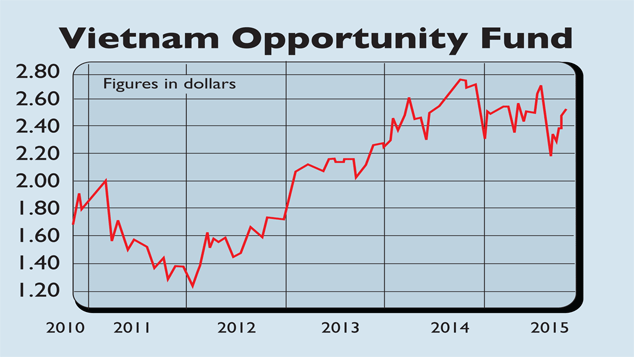Vietnam: how to invest in Asia’s new powerhouse
Vietnam is powering ahead – smart investors will pile in while it’s still attractively priced, says Rupert Foster.


Vietnam is powering ahead smart investors will pile in while it's still attractivelypriced, says Rupert Foster.
The Vietcong's Cu Chi tunnel system outside of Ho Chi Minh City is a pertinent commentary on modern Vietnam. The Vietcong operated from this tunnel system, on the edges of Saigon (the capital of South Vietnam), for the entire period of the Vietnam War. The Americans carpet-bombed the tunnels on numerous occasions, and the Australian and American "tunnel rats" led heroic sorties into the 75-mile tunnel system, but nothing budged the Vietcong.
Nowadays, young, friendly local guides try to keep straight faces as they demonstrate the many bloodthirsty methods adopted by the tunnel inhabitants for killing unwitting American and Aussie soldiers.
MoneyWeek
Subscribe to MoneyWeek today and get your first six magazine issues absolutely FREE

Sign up to Money Morning
Don't miss the latest investment and personal finances news, market analysis, plus money-saving tips with our free twice-daily newsletter
Don't miss the latest investment and personal finances news, market analysis, plus money-saving tips with our free twice-daily newsletter
However, this approach surprisingly does not alienate the visitor. There is none of the pompous lecturing or nasty underlying nationalism that you sometimes find in other parts of east Asia. The Vietnamese, even as victors, have put the war behind them and are now focused on the future and that involves making as much money as possible.
Thus the last stop on the tour around Cu Chi is a visit to the firing range, where US and Australian citizens can once again blaze away at the side of a hill with M16s in pointless anger however this time they pay in hard currency rather than with their lives. Modern Vietnam combines a heady mix of pragmatism, entrepreneurial desire and downright friendliness.
The investment case
So where does that place Vietnam as an investment for us today? Where is Vietnam in its development path right now? Well, the country has adopted the north Asian model and as a result it has become the fifth command economy in the region. The communist regime has steadily opened up its economy to capitalist forces. This process started in 1986, but only really got going in 2000. These things never go entirely smoothly, of course.
The Vietnamese economy was focused on the oil industry and a collection of larger state owned enterprises (SOEs), and this tight focus led to distortions in the economy. Vietnam aped its larger neighbour, China, by puffing up its first property bubble as its first construction boom swept through Vietnam's major cities. The stockmarket peaked in 2007 as did inflation, along with debt as a percentage of GDP at 112% (it is now back at 95% of GDP having risen from 50% in 2003). This led the government to raise interest rates, which kicked off a harsh asset-price recession. Property prices fell dramatically and the stockmarket did the same collapsing by more than 75%.
But even as this was happening, the second phase of the command-economy development path was kicking off. This phase was built on improving productivity and encouraging floods of foreign investment. In China (number four down the command economy production line), this phase ran from the late 1990s until the peak of the stockmarket bubble in 2007.
By that stage, Chinese wages and productivity were each five times higher than Vietnamese wages and productivity in other words, the countries were neck and neck in terms of unit labour costs (the labour costs incurred to generate a given level of output). Many Chinese clothing and shoe manufacturers had already moved 10%-20% of their production to Vietnam to prepare for the next phase of the country's development.
Since 2008 Vietnamese productivity has improved more rapidly than that of any of its Asian neighbours. This is the phase when the building of modern factories with advanced business operations and an abundance of cheap labour leads to dramatic productivity gains. This improvement is then helped by further foreign investment as the return on that investment is so high. This creates a virtuous circle that carries on until unit labour costs once again stop falling. In China, for example, it has slowed recently and now requires technological improvement and an explosion in domestic demand to allow another fall.
Foreign investment in Vietnam originally focused on traditional heavy industrial sectors such as steel, shipbuilding and oil production. But since 2008, increased foreign investment has been most noticeable in the electronics industry, and one country has led the way South Korea. Companies in South Korea needed a non-Chinese hub that would offer them cheap wages and the potential for equality in productivity to fight the rise of China. They also needed a friendly government the Communist regime in Vietnam, led by Nguyen Tan Dung, undoubtedly fits the bill here.
Samsung, Korea's largest business conglomerate, has invested upwards of $15bn in Vietnam building mobile phone, TV and semiconductor plants. Samsung Display announced a further $3bn TV factory expansion in August this year. Following Samsung's investment, all the other related Korean component manufacturers and large-scale competitors, suchas LG Group, have followed suit. The Vietnamese government has also played its part. Samsung will not pay corporation tax in Vietnam until well into the 2020s, and the company paid a small pittance for its large land holdings.
The next phase of development
Vietnam now has the potential to be an electronics hub to challenge its north Asian rivals over time. It is still very early days (electronics exports amounted to $40bn in 2014), but all the building blocks are in place. This process has been turbo-charged by the recent signing of the Trans-Pacific Partnership (TPP) trade deal. Vietnam is the largest net beneficiary of this agreement, which will give it access to Japan and American markets (assuming that the deal is ratified by the various signatory governments).
The next phase in this industrial development will be led by the evolution of domestic electronics businesses, founded by Vietnamese entrepreneurs who have learnt their trade working inSamsung or LG Group businesses.In the last couple of years we have already seen the emergence of some small private Vietnamese electrical components businesses, and based on historical precedent in time one of these may well prove to be the next Sony, Hon Hai,or Samsung.
With wage rates still a quarter of China's, the productivity upside that global corporations can achieve simply by relocating their production facilities to Vietnam will remain a temptation for years to come. Additionally, Vietnam, unlike its north Asian rivals, currently has a south Asian demographic make-up. In other words, it's youthful. Labour force growth is set to outstrip overall population growth (as young people join the labour market) up until 2020 on current expectations.
Traditionally, Asian fertility rates fall dramatically as the population gets richer (and in China this hasn't been helped by the one-child policy), but the Vietnamese currently remain happy breeders. In addition, with a large population (90 million strong) and a good education system (literacy rates are above 90%), Vietnam has an abundance of labour and in time will be able to carry a large middle class (currently estimated at 12 million).
Expect a consumption boom
The other driver of economic growth in the second phase of command-economy development is spending on infrastructure. Here, Vietnam does not disappoint. Infrastructure spending has risen dramatically over the last five years and the new five-year plan factors in 300% growth in road building over the five years to come (road building is central to Vietnamese infrastructure development, particularly in and around the leading cities).
Domestic consumption growth is also just starting to become an investment theme. This phase of development will see the emergence of the "middle-classification" theme, so loved by all emerging-market investors. The middle class in Vietnam is growing more rapidly than in any other country in Asia with 175% growth expected between now and 2020, which would take the size of the middle class from 12 million now to 33 million.As a result, investments that benefit from domestic consumption in Vietnam are set for dramatic growth and rapid rise in stockmarket valuation.
Lastly and perhaps most importantly of all for investors this interesting investment story is still priced attractively. The Vietnamese stockmarket is trading at a price/earnings (p/e) ratio of 12 for 2015, which falls to just ten times in 2016.
Meanwhile, earnings per share growth is expected to come in at 10% this year, and surge to 22% the next. This provides the lowest price/earnings to growth (PEG) ratio in global emerging markets. Book values also remain low trading at 1.3 times and there's a decent average dividend yield too, at around 3.6% a year. In China during this phase of development, quality blue-chip names traded at up to 30-40 times earnings at the peak of the market.Given a decent global economic backdrop, there appears no reason why the same will not be true in Vietnam.
What are the risks? Vietnam is an emerging market and a relatively early one at that, so it comes with all the normal global liquidity (basically how easy is it to get out of a position in a hurry?) and confidence issues. However, the market's focus of concern is currently on two main areas. Emerging economies have traditionally struggled to controlthe movement of their currencies.
With the advent of China's "devaluation" this summer, many investors have been concerned about the changing terms of trade (the fear that China will let its currency slide massively in order to make its exports more attractive, thus disadvantaging its smaller rivals). However,as I've previously mentioned here, I remain unconvinced that the Chinese renminbi will devalue by as much as 10% (so far it is just 3%) against the US dollar, and so I feel that this risk is largely imaginary but it will remain a focus for the market and is worth watching.
The biggest risk of all
A more important danger to keep in mind, in my view, is the risk that the leadership loses its focus on aiding the development of the economy, or makes a policy error. The government appears to be becoming progressively more reformist rather than less but backsliding is always possible.
As we can see in China, managing change and market perceptions is a particularly difficult job for autocratic ex-Communist leaders. Additionally, there is the risk that the government allows the inflation of another real-estate bubble, like in 2007. Of course, while that would be bad news in the longer run, it would also lead to dramatic rises in the stockmarket in the shorter term, so it shouldn't discourage the active investor right now.
Vietnam, as a small and early emerging market, is still in the sway of global financial-market flows, but its underlying dynamics are so structurally positive and its valuations remain so cheap that any long-term investor should feel relaxed that their contribution to Vietnam's exploding foreign capital inflows will provide very healthy rates of return for many years to come.
You can invest in Vietnam via a general emerging-market fund Vietnam is likely to have a low weighting however. For a purer play, it makes much more sense to focus on a good country-specific fund. My own favoured choice and the best-known is Dragon Capital's range of funds.
However, VinaCapital's VCG Partners Fund has also shown a strong performance and the managers demonstrate a clear understanding of the best themes to play in Vietnam at this moment. You can read more about potential ways you can invest in Vietnam in the box on page 24. My only sadness is that with all this optimism future American and Australian visitors will be so busy investing in bargains that the attractions of the Cu Chi firing range will pale by comparison.
Rupert Foster has been a pan-Asian equities fund manager for the last20 years.
The investments to buy now

As Rupert points out in the main story, several emerging- and frontier-market funds offer some exposure to Vietnam, writes John Stepek. For example, the Advance Frontier Markets Fund (LSE: AFMF) has around 15% of its assets in the country. But if you're looking for purer exposure, then there are two main options.
There's Dragon Capital, whose unit trust the Vietnam Equity Fund is open to all investors. Around a quarter of the fund is in companies that are benefiting from the commodity-price slump (milk producers and tyre manufacturers, for example), while property and construction accounts for just under a fifth. The fund is also nicely concentrated, with 21 holdings as of end September. Over five years the fund is up around 55% versus 32% for the index.
Another option comes from VinaCapital. David C. Stevenson has written regularly for MoneyWeek about their investment trust the VinaCapital Vietnam Opportunity Fund (Aim: VOF). As David points out, VinaCapital "is fairly widely held by wealth managers, largely because it's the most liquid vehicle available. Its track record isn't spotless: it has perhaps focused too much on local property projects and pricey local large-cap equities. Yet even so, I think it's a good way of buying into Vietnam and a few recent changes could make it a lot more popular.

The fund managers now plan to migrate the fund's domicile from Guernsey to the Cayman Islands, and they also intend to move the listing from Aim to London's main market. The shares will also be quoted and traded in sterling rather than US dollars, making it eligible for inclusion in the FTSE All Share index, which in turn means that UK passive trackers will start to invest in the fund." The investment trust is on a discount to net asset value (ie, you can buy the shares for less than the value of the underlying portfolio) of around 20%, though that's not unusual.
If you have a significant amount to invest (more than£100,000), investigate PXP Vietnam Asset Management, whose Vietnam-focused equity fund has performed strongly over the last few years. Finally, there are some Vietnam passive funds, but this is one of the few cases where we'd favour active over passive management because active funds are better able to invest in the Vietnamese companies you'd actually want to own.
Get the latest financial news, insights and expert analysis from our award-winning MoneyWeek team, to help you understand what really matters when it comes to your finances.
Rupert is an investment strategist and adviser at J & C Foster, providing Asian, Consumer and Global Equities Strategy advice to a number of family offices and portfolio management organisations. He writes on Asia and Global Macroeconomics for a number of investment publications including MoneyWeek and HL Investment Times.
-
 ‘Why I have ditched my Help to Buy ISA for cash savings and the stock market’
‘Why I have ditched my Help to Buy ISA for cash savings and the stock market’Without the 25% bonus, my Help to Buy ISA is effectively redundant, says MoneyWeek writer Sam Walker.
-
 Is your inheritance tax allowance cut if you sell to downsize or sell your home to pay for care?
Is your inheritance tax allowance cut if you sell to downsize or sell your home to pay for care?Downsizing relief is a little-known benefit that could save your loved ones tens of thousands of pounds in inheritance tax after you’ve died.
